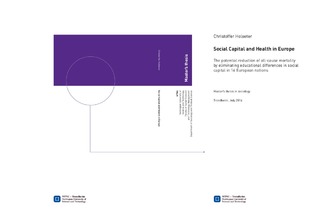| dc.contributor.advisor | Eikemo, Terje Andreas | nb_NO |
| dc.contributor.author | Holseter, Christoffer | nb_NO |
| dc.date.accessioned | 2014-12-19T14:36:59Z | |
| dc.date.available | 2014-12-19T14:36:59Z | |
| dc.date.created | 2014-09-19 | nb_NO |
| dc.date.issued | 2014 | nb_NO |
| dc.identifier | 748387 | nb_NO |
| dc.identifier.uri | http://hdl.handle.net/11250/268926 | |
| dc.description.abstract | Background: Social inequalities in health are persistent in society and remain one of the greatest challenges for public health. Europeans with lower socioeconomic status have shorter life expectancy and experience more health problems than people in the higher socioeconomic groups. Previous studies have revealed that the health impact of social health determinants may be comparable to smoking and other well-established risk factors. The main aim of this thesis is to provide estimates of the extent to which health inequalities in Europe realistically can be reduced by policies and interventions aimed at increasing the level of social capital among lower educational groups to the level seen among the highest educated.
Data and methods: For each population, social risk factor prevalence data from the early 2000s by gender, age and level of education were gathered from the first two rounds of the European Social Survey (2002 & 2004). Relative risks for the impact on mortality for the social risk factors was collected from a large meta-analytical review of 148 studies on social factors impact on health (Holt-Lundstad et al. 2010). Mortality data from a range of studies were available in the EURO-GBD-SE (2013) project data. The social risk factor prevalence data, the relative risks and the mortality data were combined in order to calculate Population Attributable Fractions (PAF) for mortality by population, level of education and gender, in order to simulate scenarios where educational differences in the social risk factors are completely eliminated.
Results: Different social risk factors were upward levelled so that all educational groups got the social risk factor prevalence currently seen in the highest educational group. The results vary from considerable reductions to no reduction at all in all-cause mortality depending on both the social risk factor, gender and country. Overall, living alone seems to be the social risk factor with least health potential, followed by marital status, while social isolation seemed to be the social risk factor with the greatest health potential. Social participation and perception of social support also seem to have a great potential for reducing educational inequalities in allcause mortality in Europe, but there are important variations between countries.
Conclusion: The findings from this thesis show a substantial theoretical modifiability of educational inequalities in mortality by increasing the levels of social capital seen in the lower educational groups to the level currently seen among the highest educational groups through Europe. Educational inequalities in all-cause mortality could be substantially reduced and deaths could be avoided if policy makers succeed with policies aimed at eliminating differences in social risk factors in Europe. However, the magnitude of the reduction varies by social risk factor, country and gender. It is therefore important for the different nations to choose the most important entry-points in their population when forming policies. | nb_NO |
| dc.language | eng | nb_NO |
| dc.publisher | Norges teknisk-naturvitenskapelige universitet, Fakultet for samfunnsvitenskap og teknologiledelse, Institutt for sosiologi og statsvitenskap | nb_NO |
| dc.title | Social Capital and Health in Europe: The potential reduction of all-cause mortality by eliminating educational differences in social capital in 16 European nations | nb_NO |
| dc.type | Master thesis | nb_NO |
| dc.contributor.department | Norges teknisk-naturvitenskapelige universitet, Fakultet for samfunnsvitenskap og teknologiledelse, Institutt for sosiologi og statsvitenskap | nb_NO |
